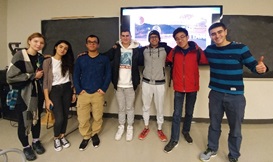Friday evening, November 2, the Biophysics Club of York University held its inaugural movie night to watch and discuss a wonderful piece of modern science fiction: The Martian. The audience spanned from kinesiology and biochemistry majors to physics and engineering majors, allowing for interesting perspectives to be shared. And so, over pizza and home-made pumpkin pie, nearly twenty students enjoyed their Friday evening together, in an interdisciplinary talk about the scientific accuracy of Ridley Scott’s 2015 film.
Can plants grow on Mars and were Mark Watney’s dangerous (and sometimes unsanitary) agricultural methods plausible strategies? This was the first question posed which opened into the first theme of discussion. To mention a few ideas: can tuber plants such as potatoes grow in the highly mineralized Martian soil with abundant perchlorate? If so, what measures would need to be taken to make the earth more suitable for growth? In the movie, the space botanist used feces to fertilize the soil and hydrazine found in rocket fuel to synthesize water... Were feces (with potentially dangerous strands of E. coli) necessarily the best source for introducing enriching bacteria flora into the soil? Not to mention the toxic byproducts of the exothermic reaction to produce gaseous hydrogen from hydrazine! Along these same lines, what about the effect of the 60% lower gravity on Mars relative to Earth when considering the plant growth (following a simple treatment in accordance with Darcy’s law)? As he continuously grew potatoes in his improvised green-house, what can be said about the dangers of monocultures of potatoes?
Thinking about the properties of the planet at a larger scale, were plants obtaining an optimal amount of light? Do solutions exist to the lower solar light intensity on Mars from the sun (e.g. systems of hyperbolic mirrors and optical fibers, different wavelength artificial light sources, etc.)? Given that Mars lacks a magnetosphere, what would happen to the potatoes that may be exposed to unimpeded damaging solar radiation? The portrayal of extraterrestrial horticulture in the Martian was a huge branching point for a discussion on astrobiology!
Overall, the movie had (very) few major plot holes. To name the biggest one, as concluded by the group, in the introductory scene, given the very low atmospheric pressure on Mars, it would be near impossible for strong enough winds to arise to knock our botanist protagonist off the ground (even with the lower gravity). On the other hand, the movie deserved much praise for its strong scientific basis.
The group was intrigued by the attention to detail in the communication lag between Mr. Watney and Nasa of nearly 7 minutes following from the speed of light limitation on propagation of information. Another point considered was the methods of power production employed by Mr. Watney during his stay on the Red Planet (such as the solar panels and radioisotope thermoelectric generator), and the consistency of the useful power production as compared to estimates of his power consumption. The movie was also commended for the accurate portrayal of muscle atrophy and body aging under the effects of lowered gravity (and potentially extended solar radiation exposure). It is interesting to note that in 2015, around the same time the novel-based movie was released in theatres, the International Space Station (ISS) was conducting the VEGGIE mission with the objective of growing “palatable” food in space, successfully producing red romaine lettuce in microgravity; the ISS was taking its own first steps towards colonizing far away worlds.
The Martian’s wide range of scientific ideas stimulated many minds all over the world. This event was a wonderful opportunity to just strike at the tip of the iceberg, engaging all these students of different backgrounds in a talk about the factors to consider during an expedition to our potential future home.